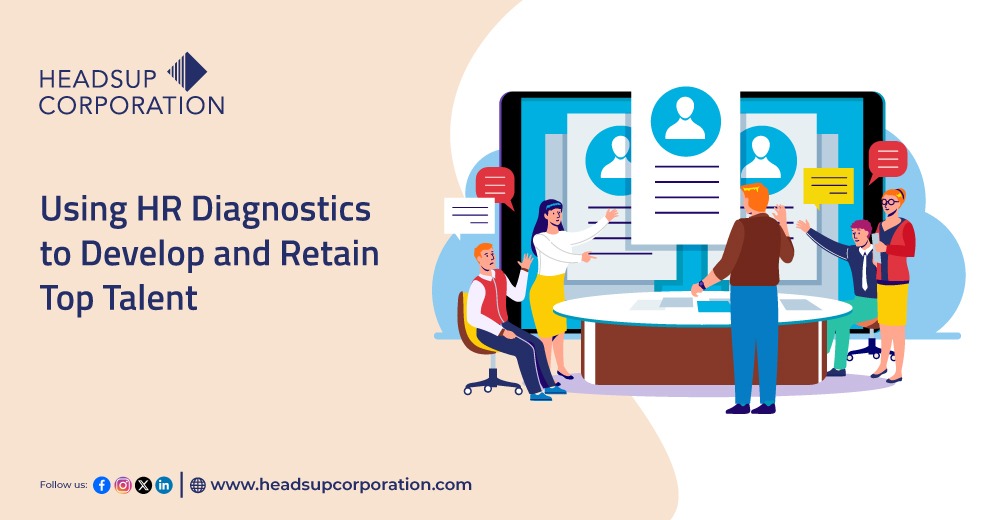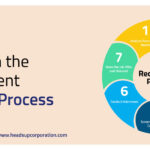
Using HR Diagnostics to Develop and Retain Top Talent
Indeed, talent is one of the most critical factors determining organisations’ success in today’s competitive business environment. HR diagnostics assist in identifying organisations’ top talent and areas of weakness within the workforce. Headsup Corporation focuses on using HR diagnostics tools to diagnose organisations to provide a solution to the challenge of the development of managerial talent. This blog is devoted to the approach describing how HR diagnostics can revolutionise talent management and ensure organisational success.
Definition of HR Diagnostics
HR diagnostics can be described as tools and methods applied in rendering analysis of some issues of the workforce. It assists the HR specialists in collecting information related to the employees’ competency, productivity, satisfaction and health. Moreover, through the implementation of HR diagnostics, it is possible to make the proper choices and improve the talent management within a company.
Types of HR Diagnostics
Assessments
These are systematic assessments used to determine the competence of employees in specific areas with in an organisation. They can be in the form of tests, simulations or practical assignments that must be accomplished. Appraisals enable one to establish the performance levels of each worker and their training needs.
Surveys
It is an instrument used to solicit the workers’ opinions on different areas of their employment experience through questionnaires. These can include issues such as employee satisfaction and motivation, manager performance, and organisational climate. Another thing that employees report in the form of surveys are trends and overall moods within the workforce.
Analytics
HR analytics is the utilisation of various analyses to comprehend the data that belongs to the human resource department. Moreover, performance comparisons such as turnover rates, employees’ performance scores, and total employee profile demographics are also important. Analytical techniques involve the analysis of the patterns to discover trends, foresee the future human resource requirements and make decisions.
Benefits of Using HR Diagnostics in Talent Management
Identifying Strengths and Weaknesses
HR diagnostics help in pinpointing the specific strengths and weaknesses of each employee. This information is crucial for creating targeted development plans that can enhance their skills and performance.
Enhancing Employee Engagement
By using diagnostics like surveys, companies can gauge employee engagement levels and understand what drives motivation. This insight allows for the implementation of strategies that improve engagement and job satisfaction.
Improving Retention Rates
Understanding the factors that contribute to employee turnover is essential for improving retention. HR diagnostics provide the data needed to address these issues, such as identifying disengagement early and taking proactive measures to retain top talent.
Making Informed Decisions
With comprehensive data from HR diagnostics, companies can make well-informed decisions about hiring, training, promotions, and other HR activities. This leads to better alignment between employee capabilities and organisational goals.
Creating a Competitive Edge
Leveraging HR diagnostics gives companies a competitive edge by ensuring that they have a skilled, motivated, and well-supported workforce. This not only boosts productivity but also enhances the company’s reputation as a desirable place to work.
Identifying Top Talent
In What Ways Does the Use of HR Diagnostics Prove Useful in Identifying Talent?
Overall, the systems we have referred to as HR diagnostics are solid instruments that can revolutionise the procedures used by corporations to select and develop the most valuable workers. HR diagnostics involve using a variety of assessments, surveys, and analytical tools that give an overall picture as of the employee’s capability, talent, and development. Such findings are of great significance for identifying several talented and promising employees who might contribute to the company’s performance.
Key Metrics and Indicators to Look For
When using HR diagnostics to identify top talent, certain metrics and indicators are particularly valuable:
Performance Metrics
BS Look at previous performance appraisal records, sales and execution records, and project successes. High-potential is a term used to refer to employees who go above and beyond what is expected of them in an organisation.
Engagement Levels: Committed employees are those who are fully involved in their work assignments and are dedicated to their organisations. That way, engagement surveys can point out who is most effective at engaging.
Leadership Potential
The characteristics of leadership include decision-making, finding solutions to problems, and motivating people. Organisational diagnostics that involve leadership can reveal who among the employees is ready for additional responsibilities.
Learning Agility
Learners are fast, which, when coupled with new hires, means that high-potential employees are capable of learning new skills quickly. The learning agility assessment tests can assist in identifying such highly adaptable people.
Cultural Fit
This implication means that employee fit is a good predictor of productivity since individuals who are in a good organisational culture are more likely to succeed. The cultural fit assessments guarantee that the affected talents conform to the culture of the organisation.
Developing Top Talent
Strategic applications of HR diagnostics are also embraced as an appropriate way of developing personal development strategies.
HR diagnostics are very useful tools which can be compared to maps for the development of employees. Overall, while analysing variant details of the particular job holder as well as employer, HR diagnostics are most useful in working out the subsequent development plans that will meet the specific requirements of the employee. Thus, the approach is quite sensitive towards employees and their needs in that specific organisation, so that the development process successfully delivers what it promotes – efficiency and effectiveness.
Promotion of the Practice of Ever Learning
Today it can be stated that in the modern world of business, continuous learning is not an option, it is a must. When the employees are able to learn new skills and update their existing knowledge they are able to remain motivated at work. In doing this, HR diagnostics are useful where there can be definite areas of development for the employees pinpointed. The promotion of this continual learning shall help the employees or the firm as it remains competitive.
Some of the development programs that can be formulated depending on the HR diagnostic results are as follows;
For instance, an HR diagnostic could show that a group of employees in an organisation is good in technical qualifications but lacks people management skills. Thus, a company may design a leadership training intervention specifically for such employees. An example could be using diagnostics to pinpoint that for a particular set of employees, in particular for those who demonstrate definite high results in creative thinking, the worst traits are observed in project management. The company can then offer specialist courses to cover each of these skills, which makes the development plan more balanced.
Retaining Top Talent
Strategic objectives of HR diagnostics on aspects of employee satisfaction and promotion of engagement.
Maintaining good employees focuses on first identifying what contributes to the satisfaction and productivity of workers in the organisation. HR diagnostics give information on the satisfaction levels of employees as it considers certain things like work environment, work description and managerial policies. The information assists organisations in comprehending the motivators of their workers and potential grievances.
Possible Business Solutions for Boosting Retention Based on Diagnostics
The data gathered with the help of HR diagnostics allow for organising particular measures that can help enhance the retention rate in a given organisation. For example, if the diagnostics revealed that the employees lack appreciation, the firm might have to develop a culture of appreciation through the provision of employee awards for good work. If the diagnostics show some problems in the area of work-life balance, the company may propose flexible working hours, or work from home. Thus with the help of determining specific issues of the HR diagnostics field, it will be possible to make workplaces more supportive and stimulating.
How to Implement HR Diagnostics in your Organisation:
- Thus, the utilisation of HR diagnostics in an organisation can be an enriching experience if well-addressed. Firstly, identify organisational requirements, collect organisational data and review results employing various HR diagnostic tools. Select the correct tools and platforms, preferably ones that are elastic, intuitive to use, and compatible with integration.
- Make sure that vendors provide good customer service and/or adequate training information. It is possible to apply the use of HR diagnostics by informing other processes in HR, implementing a trial run, constant tracking and checking, offering training sessions for personnel, and creating feedback.
- This will result in the recruitment of quality employees, effective training and more organisational employee commitment.
By following these measures you can successfully undertake HR diagnostics and improvement in talent management which will ultimately help in the engagement of the masses.
Conclusion
HR diagnostics also helps in improving talent management by defining and selecting key talent, developing career plans and strategies for the selected individuals, and increasing their commitment to the company. It affords a tactical advantage as there will be proper personnel in appropriate positions, highly motivated, and prepared for success.



